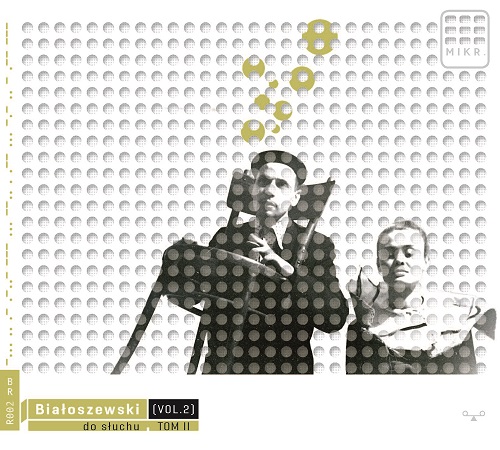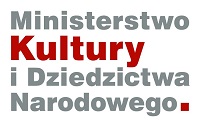|
Białoszewski do słuchu, vol. 2 - Cabaret

|
Release Date: IV 2014; Współwydawca: Fundacja
Total Time: 42:19
1CD | 10 page folded insert | digipack
Miron Białoszewski, Ludwik Hering: "Pieśni na krzesło i głos"
1. Wisi się jeść...
2. Ballada od rymu
3. Interes
4. Bajka
5. Nikt za mnie
6. Ziewy
7. Zajechałem linią...
8. Przerzut objawu
9. Zbiorowe ustalenie charakteru Pani Doktór
10. Ale szczęście
11. Wypadek
12. Wypadek z gramatyki
13. Walc – zaćmienie
14. Retory
Text: Miron Białoszewski (1, 2, 3, 9, 12, 13), Ludwik Hering (4, 5, 6, 7, 8, 10, 11, 14)
Voices: Miron Białoszewski (1, 3, 5, 7, 9, 11, 13), Ludmiła Murawska (2, 4, 6, 8, 10, 12, 14)
Recorded by Polskie Radio, Warszawa 1958
Miron Białoszewski: "Kabaret Kici Koci"
15. Wiersze Kici Koci wynajmującej barany i robiącej na drutach kiecki: A kiedy miłość...; Ach, co się stanie?; Piosenka na wyjazd; Upiję się; Było tak; Tango Kici Koci
16. Z ostatniej chwili
17. Coś ogólnego
18. Komunikat
19. Płyta wspomina
20. Oberek z bloku
21. Kabaret kici koci z cyklu globalnego
22. Kicia kocia robi doktorat...
23. To jest wszystko... (komentarz)
24. Niespodzianka na „N”
25. Przemowa Kici Koci już po otrzymaniu Nagrody Nobla
26. Moja filozoo
27. Głowa na sztylecie
28. Kicia Kocia przekopuje się przez zastraszająco narastające śniegi
29. Pustelnia 1982
30. Aha, zapomniałem powiedzieć... (komentarz)
31. Kicia Kocia na Manhattanie
32. Kicia Kocia ogląda amerykańską telewizję
33. Niagara
34. Stepy amerykańskie
35. Amerykańskie Dziady Kici Koci
36. Kabaret Kici Koci w Bufallo
37. Kicia Kocia dostaje kartkę
38. Idzie sobie człowiek ABC
39. Skakanka ufoistki
40. Na zimę
41. Kicia Kocia z Zawichostu
42. Kicia Kocia poręcza dryf
43. A oto garść mowy wiązanej...: Wodooda; Wołanie z Zawichostu do baby z mostu; Sonet zawichostski; M.; Rozmowa Wisły ze mną; (Na czarną godzinę pisany wiersz tyłem do przodu...); Piosenka placu do tańca
Text and voice: Miron Białoszewski
Recorded by Miron Białoszewski and Jadwiga Stańczakowa, Warszawa 1980-1982
ZREALIZOWANO Z UDZIAŁEM ŚRODKÓW MINISTERSTWA KULTURY I DZIEDZICTWA NARODOWEGO

|
|
| I bought a tape recorder for four thousand. When you come to Warsaw in May or June, we could do some recording. It's a good activity. Interesting to everyone.
Miron Białoszewski, April 1965
|
In April 1965, Miron Białoszewski buys a tape recorder. He intends to record “A Memoir of the Warsaw Uprising” he is currently writing, and “test himself” by performing and registering his poems on tape. Since then, in the flat at Dąbrowskiego the reels often spin, while Białoszewski reads, dictates, recites and sings to the microphone. Apart from “A Memoir...” which is entirely dictated into the tape recorder and then typed down “by ear”, in the next 2 years, he registers works of Mickiewicz, Słowacki and Norwid, fragments of the Gospel of Matthew, “Stabat Mater” and “Dies irae” hymns in his own translation, poems from the collections “The Revolution of Things” and “Było i było”, vespers sang together with Leszek Soliński and private conversations with friends.
Białoszewski treats the tape recorder as both a work tool and a toy, a gadget used for entertainment, whereas recording itself becomes a substitute for ever regretted performances of the home theatre he's been planning to revive since the closure of Teatr Osobny in 1963. In the course of time these plans appear decreasingly feasible, his works on “A Memoir...” are almost finished and Białoszewski ceases writing poems in favour of his dedication to prose. His enthusiasm about tape recording diminishes and finally, he quits the activity for quite a few years.
In the mid 1970s, his interest in it is aroused again due to the poet's acquaintance with Jadwiga Stańczakowa. In order to secure his blind friend free access to his works, Białoszewski decides to record them on tapes on a regular basis. This time recording sessions take place in Jadwiga's flat by her portable tape recorder Grundig MK 232. For the next few years, right after writing a new poem or a fragment of prose, Białoszewski – sometimes in the middle of the night – arrives at Hoża and, as Stańczakowa recalls, “in rupture and exhilaration – he records it all”. This is how this intriguing practice is established: the author's first reading of the text aloud and its recording on tape complete and finalize the process of writing. By 1982, the majority of the poet's late output is registered on tapes: hundreds of short poems, “Chamowo”, “Zawał”, fragments of “Rozkurz” and “Tajny dziennik” as well as “A Memoir of the Warsaw Uprising” and “Szumy, zlepy, ciągi”. Many of his works are recorded by Białoszewski in the professional studio of the Polish Radio which, at Stańczakowa's instigation, he often visits from the mid 1970s.
This way, during the 17 years an unusual sound archive is created – an archive which constitutes a remarkable phenomenon in the Polish culture, both due to its volume (12 preserved tapes from the 1960s and several dozen tapes recorded in Jadwiga Stańczakowa's home altogether add to over 80 hours of materials, without even counting those maintained in the radio archives) and with regards to the nature of those recordings and their place among other Białoszewski's accomplishments. They are closely related with his characteristic vision of literature.
“I strive for the written to register the spoken. And I wish writing wouldn't eat speaking. What is found valuable in the spoken language, gets written down. What is valuable in the written language, is then spoken out loud”, he wrote in “Mówienie o pisaniu”. He called the invention of quiet reading a misunderstanding. He also declared, “I always considered poetry as something to be read aloud […] Poetry reaches its full being when it is spoken out loud.”
If, according to Białoszewski, a poem only starts to fully exist in being performed aloud, it is the recordings that give us the fullest insight into the matter of his creative output and let us truly see how these texts were intended by their author. Graphic notation is merely a score requiring a complementary voice, while proper pieces should be “fully heard”. This is confirmed by Białoszewski's own performances recorded on tapes. The author uses tempo, rhythm, the voice volume and melody with intensity to be rarely encountered in the Polish tradition of poetic readings, and thus he makes the sound one of the basic dimensions of his texts.
Despite the above, in reception of Białoszewski's output, the recordings have not occupied a position they deserve. Kept as a part of the collection of the Museum of Literature in Warsaw, they are only known to the small circle of experts and the poet's close friends. The series “Białoszewski by Ear” is the first to bring them to light and make them available to the wider audience.
***
“Perhaps it should have been sang, perhaps for sure (…), because at the beginning when it was composed, it was memorized – without writing it down but aloud – by ear (…) and so it went on. As singing. As speaking-singing. With stressing – let us say – the beginning of a word.”
These few sentences are a fragment of casual reconstruction of poetry sources conducted by Miron Białoszewski in his intriguing text “O tym Mickiewiczu jak go mówię”. Primal singing or speaking-singing becomes here a synonym of the most natural and accessible way of creating poetry which is alive because passed on by the word of mouth. And it is all about this: “so that it goes on. And is popular. Functions. Lives.” The criterion of literary efficacy – formulated this way – is one of the keys opening the world of Białoszewski's poetic fascinations and inspirations. If, in this world, psalms and sacred hymns co-exist in harmony with backyard ballads and popular street songs, it is possible precisely because both the former and the latter preserve some of the lost oral aspect – the unity of poetry and music which doesn't allow poetry to be a dead letter.
The nearest Białoszewski himself could draw to this unity was in theatre, by performing his own texts in front of the audience. Formal research he made in this field, together with Ludwik Hering and Ludmiła Murawska, to a great extent focused on exploring space between singing and speaking – characteristic of oral poetry. “We often had particular speakings (calculated according to their own melody but still speakings), straightforward singing and singing-speakings, on the edge, which turned out to be pretty broad as there appeared a variety of almost singings, crooning speaking, sections of monotones or the opposite – rhytmic pile-ups becoming music of its own urge”, the poet recalls.
One of the most vivid examples of using such means was Białoszewski and Hering's work “Pieśni na krzesło i głos”, also called “Kabaret”: a collection of 14 (and later 16) grotesque poetic texts, half-spoken, half-sung by Białoszewski and Murawska to the accompaniment of the rhythm tapped by the poet on the chair hanging from his neck. “Pieśni...” are the most direct link between Białoszewski's theatre activities and his poetry: some of the texts performed in this series were included in later published Białoszewski's poetry books, while their presence on stage characterized by such an expressive performative formula – similarly to the whole theatrical experience of the author – could be considered as a basis of further artistic practices of Białoszewski as a poet who performed his own pieces aloud. The only existing audio recording of “Pieśni...” is the one presented here, recorded by the Polish Radio in 1958, the year of the series' premiere.
Almost 20 years later, Białoszewski's passion for melic poetic forms was channeled in another series of works entitled “Kabaret”: in “Kabaret Kici Koci”. This cycle was initiated in the late 1970s as a social joke but it turned out to be so catchy that the poet eagerly developed it through the following years, almost by the end of his life. It is composed of humorous poems sung by Białoszewski along melodies of oberek, tango, waltz and other popular tunes as well as absurd comic scenes as if from Gałczyński's “Teatrzyk Zielona Gęś”, mockingly commenting on the Polish reality of the early 1980s. The “Kabaret” poems are rhymed, rhythmical and “inserted into melodies” in an exaggerated, parody-like manner as their nature is purely entertaining: performing them is supposed to, above all, make the listeners and the author himself have fun. Białoszewski even claimed that while creating this series, he took from his experiences of reciting poems at name day parties. The oral, melic model of poetry is, therefore, regained from an elementary, even trivial social situation – which doesn't seem to weaken its efficacy but to strengthen it.
“Kabaret Kici Koci” recordings collected on the album “Białoszewski by Ear – Volume II” are a part of Jadwiga Stańczakowa's tape archive. They were made in the years 1980-1982 and are a complete set of texts from this series performed by the author which were registered on tapes. Among the presented poems, there is also Miron Białoszewski's commentary on the genesis of “Kabaret”.
Maciej Byliniak |
|